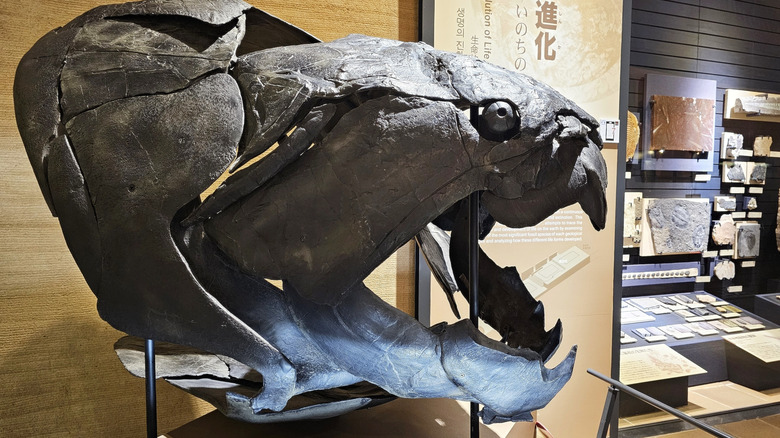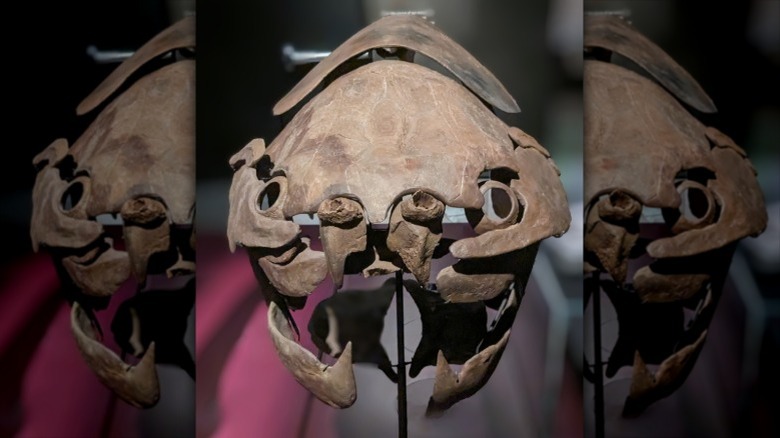What Really Caused This Prehistoric Nightmare Fish To Go Extinct
There are plenty of contemporary creatures that inspire fear. For example, the northern green anaconda is the heaviest snake in the world and weighs more than a football player. Should you encounter one of these giants, it could squeeze the life out of you with ease. Then there's the great white shark, which is surely one of society's biggest collective fears. But while there are plenty of current-day nightmare creatures, the most horrific monsters to ever stalk the Earth all seem to have lived during prehistory.
There are so many prehistoric creatures that meet the definition of nightmare fuel that frankly, it seems like a real blessing they've gone extinct. Consider, for instance, the terrifying snake uncovered in India which was longer than a bus and would make today's northern green anaconda look like nothing more than a common grass snake. What's more, prehistoric sea animals were uniquely nightmarish. The megalodon, for instance, lived during the Miocene and Pliocene Epochs (between eight and 20 million years ago) and could reach lengths of up to 82 feet, which considering the longest ever great white was just 21 feet should give you some idea of just how incomprehensibly frightening the megalodon really was.
Just in case you needed one more chilling prehistoric sea creature to add to the list, the Dunkleosteus was a genus of underwater armored apex predators that could reach lengths of more than 30 feet and even fed on sharks. Yet another example of why extinction isn't always necessarily a bad thing, the Dunkleosteus disappeared around 359 million years ago. Why? Well, that's not entirely clear.
Dunkleosteus: one of the most terrifying predators to ever exist
The Dunkleosteus was a truly formidable predator which inhabited the ancient seas of the Devonian Period between roughly 419 million and 359 million years ago. The enormous fish, which belongs to the group of armored fish known as placoderms, was discovered by amateur paleontologist Jay Terrell and his son on the Lake Erie cliffs near the town of Sheffield Lake in Ohio back in 1867. The unusual creature is thought to have reached weights of up to four tons and lengths of up to 33 feet, making it larger than any modern great white shark. It should be noted, however, that a 2023 study in the journal Diversity suggests the fish was much shorter than initially thought, but its length certainly wasn't the most terrifying aspect of this ancient predator.
Dunkleosteus had some of the most intimidating jaws of any predator to ever exist. Rather than teeth, the fish had long razor-sharp bone edges that protruded from their mouths and acted as blades to rend prey with ease. According to a 2006 study in Biology Letters, the Dunkleosteus' jaws produced the greatest potential bite force of all living or fossil fishes, with 11,000 pounds of force. What's more, these proto-teeth actually self-sharpened as they rubbed together, and the Dunkleosteus was able to open its mouth so rapidly that it formed a sort of suction that drew prey into its mouth. With all that in mind, you have to wonder what sort of cataclysmic event could possibly wipe out such a formidable apex predator.
What wiped out the Dunkleosteus?
Dunkleosteus fossils have been found in Canada, the United States, Western Europe, and northern Africa, and from the multiple fossils that have been excavated, 10 species of Dunkleosteus have been identified. But what exactly caused these mighty fish to die out in the first place?
Well, Earth has seen five mass extinction events thus far, and it seems an aftershock to one of these could have been responsible for killing off the Dunkleosteus. The Hangenberg extinction event, along with the Late Devonian mass extinction 13 millions years earlier, is thought to have wiped out as many as 70–80% of all species on the planet. While scientists remain unsure what exactly prompted this mass extinction, one theory is that it was caused by a sudden global shift from greenhouse to icehouse climate conditions. which resulted in a massive drop in oxygen levels in the ocean. This left placoderms in a precarious situation, essentially making it impossible for fish such as Dunkleosteus to breathe, thereby ensuring their extinction. Other theories posit that a comet hit our planet, resulting in a global ecosystem collapse that ultimately led to the extinction of so many species. Researchers point to a crater in lake Dalarna, Sweden known as the Siljan Ring as the likely point of impact for this comet.
Of course, multiple factors could be at play in the extinction of the Dunkleosteus. It has been suggested that both Dunkleosteus and its fellow placoderms could have faced stiff competition from smaller fish and sharks, which would come to rule the oceans in the millions of years that followed the extinction of the placoderms. What's more, smaller fish which lacked the armor of the Dunkleosteus actually seemed to have been more resilient in the face of mass extinction events than the placoderms and their jawless counterparts, ostracoderms. Even if a larger cataclysmic event dealt the final blow, this theory regarding smaller fish out-competing placoderms prior to the mass extinction events could well have played a factor in the Dunkleosteus' demise.


